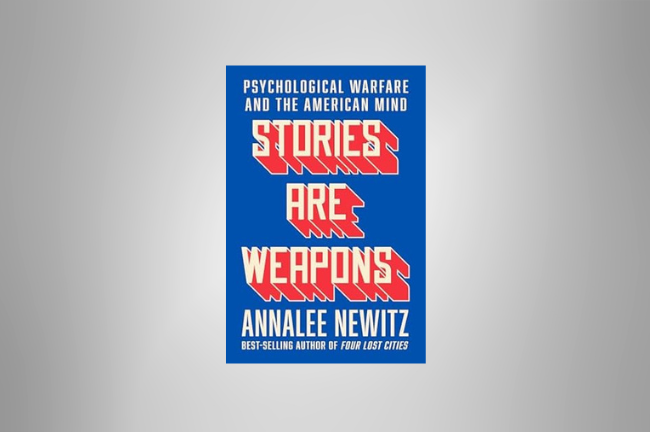You have /5 articles left.
Sign up for a free account or log in.

W.W. Norton
Annalee Newitz is a journalist who reports on science, technology and culture. They are also an accomplished science fiction writer—a complimentary set of pursuits, it seems, given that the distance between science fiction and what’s in the news is narrowing ever more all the time.
That convergence drives Newitz’s Stories Are Weapons: Psychological Warfare and the American Mind (W.W. Norton). A work of narrative nonfiction, it takes its bearings from the work of Paul M. A. Linebarger (1913–1966), author of the original U.S. Army manual on psychological warfare but also—under the pen name Cordwainer Smith—one of science fiction’s most imaginative and enigmatic figures.
What the author initially intended as a short manifesto turned into a research project taking two years, with the intensive exploration of sundry rabbit holes. The subjects making their way into the book include: the American Indian Wars (better characterized as a war on Indigenous peoples); the psychology of the authoritarian personality; the War Department’s launch of a Propaganda Section during World War I; Edward Bernays’s application of his uncle Sigmund Freud’s theories to the field of advertising; the gender politics of early comic books (including censorship campaigns); the role of the Russian state’s Internet Research Agency in the 2016 election; and the specific qualities and functions of off-line libraries.
The heterogeneity of topics here is evidence of a mind in pursuit of ever more context in making sense of confusing realities. The author is mapping a maze. The challenge can be absorbing to follow, but connections made along the way do not necessarily stick in the reader’s memory.
Reducing the book to the barest terms, Stories Are Weapons contends that our “culture wars” are akin to the “psyops” (psychological-warfare operations) developed by Linebarger and other professors–turned–military officers in the 1940s.
A psyop is propaganda—although not in the ordinary, civilian understanding of propaganda as untruthful or misleading. Psyops are crafted with subtlety and finesse to evoke in a target audience specific feelings, attitudes, behaviors, etc., that may be useful to the conduct of kinetic warfare (i.e., the sort actively engaged in killing enemy combatants).
The radio programs broadcast by both Axis and Allied countries, for example, offered listeners on the other side music or other entertainment suited to their taste, plus messages intended to damage their confidence in the war effort—including accurate reports of bombings or defeats in battle that had been suppressed by the authorities. The truth could be demoralizing; the trick was to get it into circulation, to challenge “control of the narrative,” as it’s put nowadays.
When the U.S. entered World War II, Linebarger was a political scientist at Duke University with a fluency in Chinese (acquired during his unusually peripatetic childhood) that made him an obvious asset in the Pacific theater. From the little I have read of his work, Linebarger seems to have been highly skeptical of what the discipline of psychology could contribute to military activity. But he brought something valuable to psywar strategy: an awareness that cultural difference had to be a factor in any effort to influence target populations. Ethnocentrism could render a message ineffective or counterproductive.
Psychological Warfare (1948), a textbook synthesizing his experience of working on psywar campaigns, was published not long after Linebarger’s return to academia as a professor at Johns Hopkins University’s School of Advanced International Studies. By the time a second edition came out in 1954, anxieties were high—especially in the United States—over the belief that the Communist bloc had developed powerful mind-control techniques, a.k.a. brainwashing.
Fear that the enemy might possess such powers also inspired public worry that the authorities on one’s own side might be developing such methods for domestic use, possibly by means of mass media. (Television was a particular focus of concern.)
The Cold War was, in large measure, a psywar: one conducted both on the geopolitical stage and within the public imagination.
To strip a complex history down into very schematic terms, that paranoia and free-floating hostility are still alive, making use of whatever advances in technology come to hand. Malice and weaponized disinformation campaigns are not just factors in the public sphere but seemingly a permanent part of it.
Newitz ends on an optimistic note, or at least the suggestion that a psywar driven by good will and respect for others might be possible. Readers’ capacities to imagine this may vary and are subject to pending developments.




